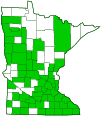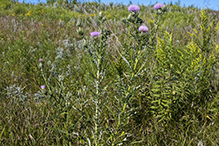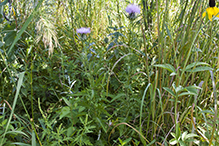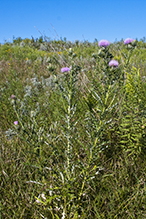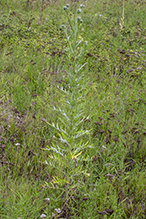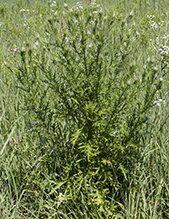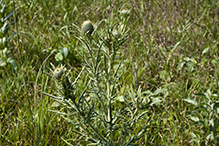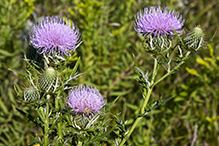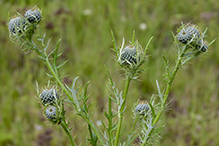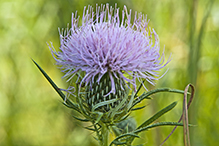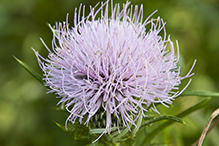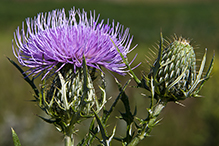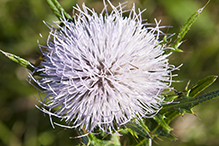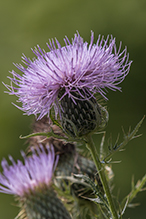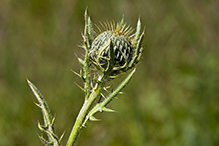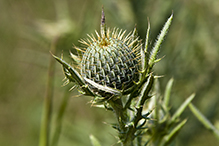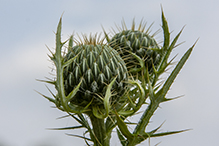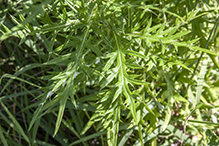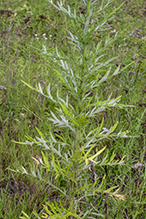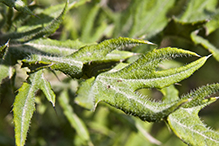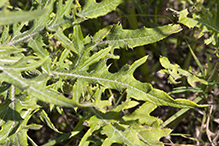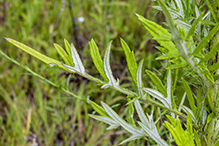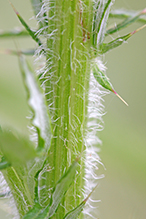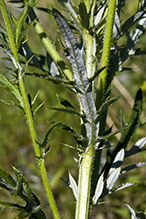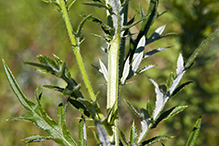Field thistle
(Cirsium discolor)
Conservation • Wetland • Description • Habitat • Ecology • Use • Distribution • Taxonomy
Conservation Status |
|||
| IUCN Red List | not listed |
||
| NatureServe | N5? - Secure SNR - Unranked |
||
| Minnesota | not listed |
||
Wetland Indicator Status |
|||
| Great Plains | FACU - Facultative upland |
||
| Midwest | FACU - Facultative upland |
||
| Northcentral & Northeast | UPL - Obligate upland |
||
Description
Field thistle is a 36″ to 84″ tall, erect, biennial or short-lived perennial forb that rises on a single stem from a slightly thickened taproot and fibrous roots.
The stems are erect with few to many ascending branches. They are covered with long, white, spreading, unmatted, soft hairs when young, becoming almost hairless as they age. They are not winged and do not have spines.
In the first year the plant appears as a rosette of basal leaves. In the second year it sends up a flowering stem.
Basal leaves are firm, broadly lance-shaped to egg-shaped or elliptic in outline, 4″ to 20″ long, and 1½″ to 9″ wide, but usually no more than 10″ long and 5″ wide. They are bluntly angled or sometimes rounded at the tip and taper at the base to a winged leaf stalk. They are deeply lobed (pinnatifid), the lobes cut more than halfway to the midrib. The upper surface is green and hairless or moderately covered with stiff, straight hairs. The lower surface is white and densely covered with felty hairs. The margins are coarsely toothed, spiny, and rolled under. Basal leaves are usually absent at flowering time.
Stem leaves are similar, alternate, stalkless, 1½″ to 10″ long, and ⅜″ to 5″ wide, becoming smaller as they ascend the stem. The leaf bases are sometimes somewhat clasping but do not extend down along the stem. The leaves at the branch tips are smaller. The upper leaves are well developed.
The inflorescence is usually a single flower head, sometimes a few flower heads, at each branch tip. The flower heads are stalkless or on short stalks (peduncles). The peduncles are leafy, up to 2″ long, and are not overtopped by upper stem leaves. Each head is subtended by a ring of spiny, leaf-like bracts. These bracts arch upward and encage the developing flower head at first, spreading gradually as the head matures.
The whorl of bracts at the base of the flower head (involucre) is egg-shaped to broadly cylinder- or bell-shaped, ¾″ to 1⅜″ long, and ⅝″ to 1 3 ⁄16″ wide, as long or longer than wide. It usually has a few cobwebby hairs. The bracts of the involucre have a 1 ⁄16″ to 3 ⁄16″ long, straw-colored spine at the tip.
The flower heads are 1½″ to 2″ wide. There are numerous pale, pinkish-purple, tubular flowers.
The fruit is a tan to brownish, ⅛″ to 3 ⁄16″ long achene (cypsela). The cypsela has a straw-colored collar near the tip and a tuft of white hairs at the tip.
Height
36″ to 84″
Flower Color
Pale pinkish-purple
Similar Species
Bull thistle (Cirsium vulgare) stems have wings with spiny margins. The leaf bases extend down along the stem. The underside of the leaf is green.
Flodman’s thistle (Cirsium flodmanii) is a shorter plant, usually no more than 32″ in height. The stems remain densely white tomentose with age. The upper leaf surface is tomentose when young. The flower head is not subtended by a ring of spiny bracts. The flower head is smaller, no more than 1″ wide. The collar on the cypsela is yellow and conspicuous.
Tall thistle (Cirsium altissimum) leaves are shallowly lobed, the lobes cut less than ⅓ of the way to the midrib.
Habitat
Dry to moderate moisture. Prairies, fields, forest openings, river bottoms, roadsides, disturbed areas. Full sun.
Ecology
Flowering
July to October
Pests and Diseases
Use
Distribution |
||
|
Sources Biodiversity occurrence data published by: Minnesota Biodiversity Atlas (accessed through the Minnesota Biodiversity Atlas Portal, bellatlas.umn.edu, 11/13/2025). |
|
| 11/13/2025 | ||
Nativity |
||
Native |
||
Occurrence |
||
Common |
||
Taxonomy
Kingdom
Subkingdom
Pteridobiotina
Phylum
Tracheophyta (Vascular Plants)
Class
Order
Asterales (Sunflowers, Bellflowers, Fanflowers, and Allies)
Family
Asteraceae (Sunflowers, Daisies, Asters, and Allies)
Subfamily
Carduoideae (thistles and allies)
Tribe
Cardueae
Subtribe
Carduinae (thistles and burdocks)
Genus
Cirsium (plume thistles)
Tribe
Cardueae is a synonym of the tribe name. Cynareae was published first and has precedence. Nevertheless, most sources use the name Cardueae for the tribe.
Subordinate Taxa
Synonyms
Carduus discolor
Cirsium altissimum ssp. discolor
Cirsium altissimum var. discolor
Cnicus altissimus var. discolor
Cnicus dicolor
Serratula discolor
Common Names
field thistle
pasture thistle
Glossary
Achene
A dry, one-chambered, single-seeded seed capsule, formed from a single carpel, with the seed attached to the membranous outer layer (wall) only by the seed stalk; the wall, formed entirely from the wall of the superior ovary, does not split open at maturity, but relies on decay or predation to release the contents.
Bract
Modified leaf at the base of a flower stalk, flower cluster, or inflorescence.
Involucre
A whorl of bracts beneath or surrounding a flower, flower head, or flower cluster.
Peduncle
The stalk of a single flower or flower cluster.
Pinnatifid
Deeply cut, more than half way to the midrib but not to the midrib, into lobes that are spaced out along the midrib; the lobes do not form separate leaflets.
Tomentose
Densely covered with short, soft, matted or tangled, woolly, usually white or silvery hairs.
Wing
A thin, flat, membranous, usually transparent appendage on the margin of a structure.
The Native Thistle Test
Thistles native to Minnesota do not have spiny stems. Grasp the stem near the base of any native thistle loosely in your fist, then slide your fist upwards to just below the inflorescence. If the plant is a native thistle, you will not get a single prickle – it will be “ouchless”.
If the thistle in question is thought to be an exotic (non-native) species, this test is not recommended.
Field thistle is native.
Visitor Photos
Share your photo of this plant.
This button not working for you?
Simply email us at info@MinnesotaSeasons.com.
Attach one or more photos and, if you like, a caption.
Bobbi Johnson |
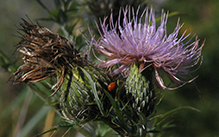 |
Luciearl |
||
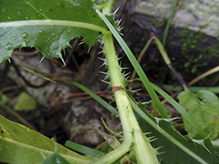 |
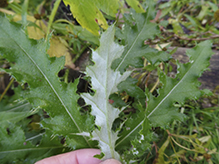 |
|
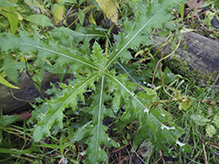 |
||
MinnesotaSeasons.com Photos

Slideshows
Cirsium discolor (Pasture Thistle)
Allen Chartier
Cirsium discolor PASTURE THISTLE
Frank Mayfield

Visitor Videos
Share your video of this plant.
This button not working for you?
Simply email us at info@MinnesotaSeasons.com.
Attach a video, a YouTube link, or a cloud storage link.
Other Videos

Visitor Sightings
Report a sighting of this Plant.
This button not working for you?
Simply email us at info@MinnesotaSeasons.com.
Be sure to include a location.
Minnesota Seasons Sightings
Bertram Chain of Lakes Regional Park
Carpenter St. Croix Valley Nature Center
Carver Highlands WMA, South Unit
Charles A. Lindbergh State Park
Forestville/Mystery Cave State Park
Hardscrabble Woods / MG Tusler Sanctuary
John Peter Hoffman Spring Brook Valley WMA
Minnesota Valley NWR, Wilkie Unit


